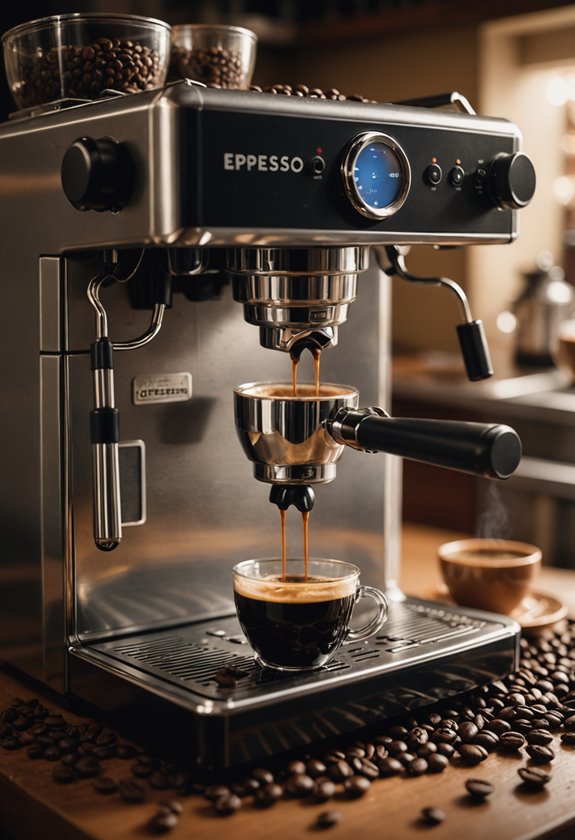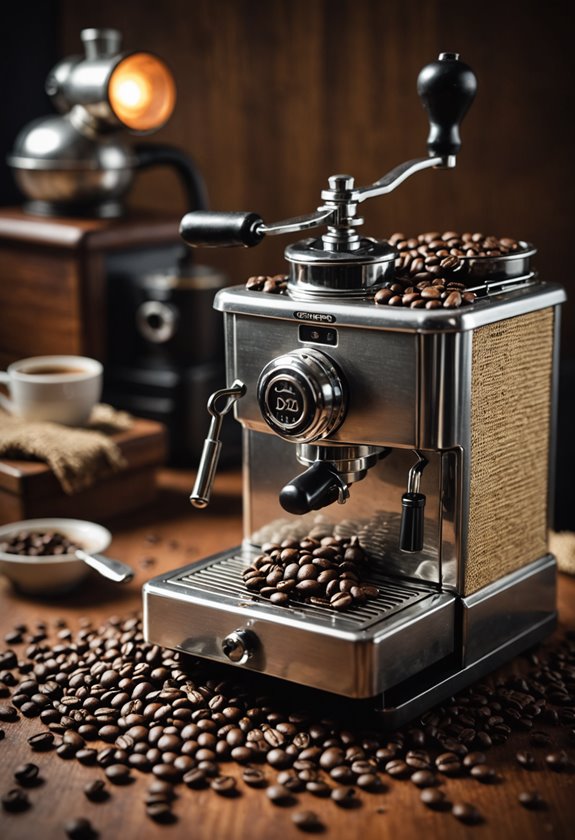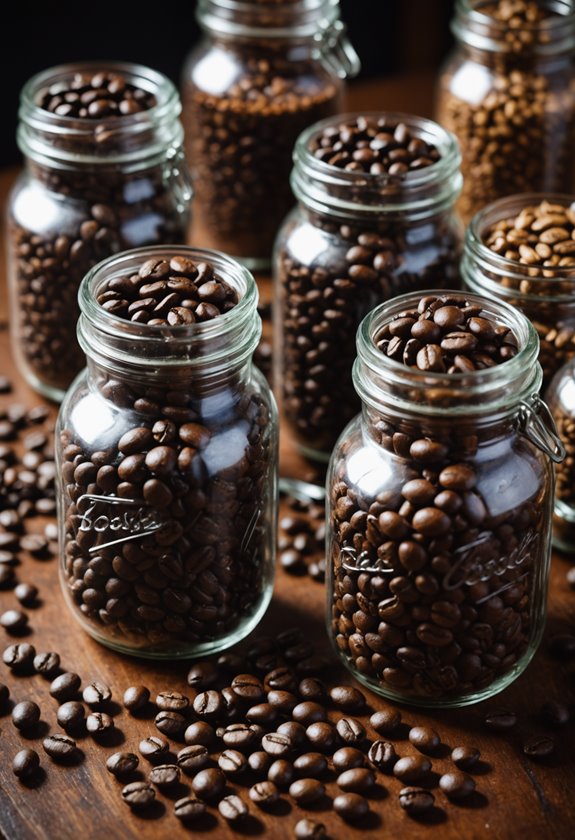Can You Use Coffee Beans in an Espresso Machine?
You can use regular coffee beans in an espresso machine, but for the best experience, let's investigate why espresso beans are preferred. Espresso beans are typically roasted darker, offering richer, bolder flavors and a smoother mouthfeel due to their higher oil content. The grind size matters too; a fine grind is essential for the high-pressure extraction that espresso demands. When you use espresso-specific beans, you increase the chances of achieving that signature crema, the creamy foam layer that tops a great shot of espresso. Choosing beans like Lavazza Super Crema could enhance your coffee adventure. Uncover how refining your bean choice impacts your brew.
Key Takeaways
- Espresso machines require dark roasted beans for optimal flavor and crema.
- Coffee beans need a fine grind size for proper extraction in espresso machines.
- High oil content in espresso beans enhances crema and mouthfeel.
- Using non-espresso beans may result in poor flavor and extraction.
- Espresso machines perform best with freshly roasted and ground beans.
Understanding Espresso Brewing

To excel in espresso brewing, you'll need to focus on a few key elements. First, understand that coffee beans for espresso are often dark roasted. This roast level enhances the rich, bold flavor profile that's characteristic of a good espresso shot. While you can use any coffee bean in an espresso machine, those specifically roasted for espresso can yield better consistency and flavor.
An essential element in espresso brewing is the high pressure used to extract concentrated flavors. Your espresso machine forces hot water through the finely ground beans, creating a full-bodied and aromatic espresso shot. Consistency in grind size is fundamental here; if the grind is uneven, it can lead to uneven extraction, affecting the taste.
Freshly roasted coffee beans are recommended for the best results, ideally used within 7-21 days post-roast. This guarantees the crema—an important component of espresso—forms properly while maintaining peak flavor extraction. Popular options like Lavazza Super Crema offer a balanced, aromatic experience with a light-medium roast that's perfect for automatic espresso machines.
Let's investigate the complexities of choosing the right beans and perfecting the grind to enhance your espresso experience. With these tips, you'll be well on your way to crafting a delicious, professional-quality espresso every time.
Coffee vs. Espresso Beans
While any coffee bean can technically be used in an espresso machine, there's a distinct difference between regular coffee beans and those specifically prepared for espresso.
Let's investigate these differences.
Roast Profile and Flavor Extraction
Espresso beans are usually roasted darker than regular coffee beans. This dark roast profile enhances the strong, bold flavors needed for high-pressure brewing.
The darker roast helps in achieving ideal flavor extraction, leading to the rich, sometimes bitter taste that espresso lovers enjoy. In contrast, regular coffee beans mightn't deliver the same flavor intensity when used for espresso.
Crema and Grind Size
One of the unique features of espresso is the crema, a foamy layer on top of the shot.
Espresso beans often have an oily surface, which contributes to this crema and overall mouthfeel. The grind size is another vital factor; espresso requires a much finer grind than regular coffee.
This fine grind guarantees the right flavor intensity and crema during brewing.
Using a conical burr grinder ensures the most consistent grind size for optimal espresso extraction.
Coffee vs. Espresso Results
While you can use various coffee beans in an espresso machine, those not intended for espresso might lead to disappointing results.
The specialized roast profile and grind size of espresso beans are key to achieving that perfect shot.
Grinding for Espresso

Achieving the perfect espresso shot hinges on the grind size of your coffee beans. Espresso coffee beans require a fine grind size to guarantee that your espresso machine can extract the maximum flavor and crema.
Using a burr grinder is recommended because it produces a uniform grind size, which is vital for peak extraction. Uneven particles can lead to an inconsistent extraction, negatively impacting the taste of your espresso.
Importance of Freshly Ground Beans****
When grinding for espresso, it's imperative to use freshly ground coffee beans. Ground coffee starts to lose its flavor and aroma quickly, so aim to use the ground espresso coffee beans within minutes.
This freshness helps retain the lively flavors and rich aromas that make espresso so enjoyable.
Achieving the Right Weight and Fineness****
For a single shot, use about 7-8 grams of coffee beans, guaranteeing they're ground to the appropriate fineness. The grind size directly impacts the extraction process, affecting the espresso's taste and texture.
By focusing on uniformity and freshness, you'll be well on your way to crafting a delicious espresso.
A grinder like the Fellow Opus Conical offers 41 precise settings to help you dial in the perfect espresso grind size.
Let's investigate these steps to understand how they contribute to creating a perfectly balanced espresso shot.
Flavor and Oil Content
Grinding your espresso beans properly sets the stage for another key aspect: the flavor and oil content of the beans. Espresso beans, roasted longer and at higher temperatures, boast a higher oil content than regular coffee beans. This oil content is vital for the rich crema that tops your espresso shot and contributes to the flavor profile you savor. Let's examine why this matters.
During the brewing process, the natural oils in espresso beans form an oily sheen on the surface, essential for emulsifying and creating that golden, creamy crema. This layer enhances the espresso's mouthfeel, making each sip smoother and richer.
Unlike regular coffee beans, which generally lack this oiliness, espresso beans deliver a strong flavor, offering a thicker and more intense taste experience.
The fine grinding of espresso beans maximizes oil extraction, essential for achieving that ideal flavor and crema. When you brew, these oils meld with the water, producing a shot full of character and depth.
Premium brands like Lavazza Gran Crema are specifically crafted to deliver the perfect balance of oils and flavor for automatic espresso machines.
Choosing the Right Roast

How do you choose the right roast for your espresso machine? Well, it starts with understanding the characteristics of espresso beans. Typically, these beans are roasted longer and darker than regular coffee beans. This longer roasting process results in a richer, more intense flavor and an oily surface, which is vital for that perfect espresso shot.
When deciding on a roast, keep these points in mind:
- Medium to Dark Roasts: These are often preferred for espresso as they enhance the flavor profile and crema quality. They usually have flavor notes like chocolate and caramel, which pair well with milk-based drinks like lattes and cappuccinos.
- Light Roasts: While they might offer brighter flavors, they can also lead to higher acidity. This mightn't be ideal for espresso drinkers who prefer a balanced taste.
- Personal Preference: Your taste plays a significant role. Experimenting with different espresso blends and roast coffees can help you find the roast that best suits your palate.
For the best results, consider machines like the Breville The Bambino that heat up quickly, ensuring optimal extraction from your chosen roast.







